The Importance Of Media Education: An Open Letter To MIT
December 16, 2008
From 2003-2005, I earned my Masters at MIT’s Comparative Media Studies program, led by its inspiring co-founders, Henry Jenkins and William Uricchio. Jenkins recently announced his departure from MIT at the end of this academic year. Henry sincerely struggled with the decision, but I — and my classmates — think he made the right one. MIT never gave CMS the resources it needed, and Henry and William could only compensate for so long. Ten years, in fact.
Henry’s departure had a silver lining: It brought my classmates together to reflect on the importance of the kind of media education we experienced. The coming together was virtual: We wielded new media tools to collaboratively craft an open letter to the Institute. It took us weeks of writing and re-writing, emails, and phone calls. The group’s balance of effort, and sense of respect, common purpose, and fun makes me proud.
So does the result:
Why We Need Comparative Media Studies
— an open, collaboratively written letter to the Massachusetts Institute of Technology
December 5, 2008
Dr. Susan Hockfield, President
Massachusetts Institute of Technology
77 Massachusetts Avenue
Cambridge, MA 02139-4307
Dr. Hockfield:
The Massachusetts Institute of Technology is known globally for bringing the best and the brightest together in a hotbed of intellectual energy, innovation, and applied study. Increasingly, its reputation for academic leadership is reaching beyond science, engineering, and economics and into the humanities. As graduates of MIT’s Comparative Media Studies (CMS) Masters program, we have seen firsthand the role this visionary program plays in the wider world. Recently, CMS co-director Henry Jenkins III announced his plans to leave the Institute for a post at the University of Southern California, leaving only one dedicated faculty member — co-director William Uricchio — and an uncertain future for both the graduate and undergraduate programs. This decision has inspired us, the CMS Class of 2005, to reflect on our program’s unique and important approach to the study of media and technology. We urge you, Dr. Hockfield, and others in the Institute’s leadership, to give the support Comparative Media Studies needs to truly succeed at MIT.
Every fall, Professors Jenkins and Uricchio welcome a small cohort of students and professionals to a two-year graduate experience that will transform them into the media experts that industry and academia increasingly seek. The co-directors, whose complementary experience and leadership styles have been key to the program’s success, practice a philosophy they call “applied humanities”. With so much of our time spent interacting through and with media, applied humanities calls for a greater understanding of its historical, cultural, economic, and global context. Everyone — business and government leaders, journalists, educators, and citizens — benefits from humanities learning, including the ability to read, write, and circulate information to diverse audiences, across distribution channels that vary in their form and content demands. Applied humanities blends traditional academic research with hands-on engagement in the public and private sectors. Comparative Media Studies creates the environment for such principles to flourish by bringing together students from a wide range of fields, including education, film and video preservation, journalism, advertising, software development, and venture capital. The program’s deeply collaborative environment turns out thinking-practitioners who can translate for a broader public and ask forward-looking questions. How is social networking changing politics? What are the ethics of video games? What happens when popular cultures move across national borders? What is the future of digital reading?
Our rapidly changing times also call for the remembrance of technological and media history, lest we remain caught up in our societal fascination with newness. CMS reminds us that early radio in the 1920s and comics in the 1950s triggered moral panics over our “impressionable” youth — fears which we look back on as reactionary and simple-minded, even as the same turns of phrase are employed over certain video games and social networking sites today. Meanwhile, the asynchronous debates of Current TV and Twitter are pulling the political town hall meetings of the past into the 21st century, and Obama’s weekly online video address is bringing F.D.R.’s fireside chats to YouTube. From Herodotus, to the printing press, opera, and silent film, the CMS program’s deep grounding in history has taught us to apply an active historical frame in our professional roles shaping media business and policy.
We have had three years since graduation to test what Jenkins, Uricchio, and a supporting team of non-CMS faculty have imparted: in industry, academia, non-profits, and beyond. We’ve brought our talents for reflective communication to books, blogs, video games, and top Ph.D. programs. Many of us have created our own job descriptions. As Jenkins explains, the CMS program prepares students for jobs that may not have existed just a few years ago, yet are becoming vital to public and private sectors in flux.
Comparative Media Studies is not the only top-notch media program out there, but it is one of very few in the United States. As a field, media studies is often ensconced within humanities and social sciences departments, with limited exposure beyond pre-existing disciplines such as sociology, film studies, art history, or education. Forging a new paradigm for intellectual accomplishment means breaking down barriers between academic disciplines in non-tokenistic, durable ways. In the seemingly unlikely setting of MIT, applied humanities has flourished, with students drawing from urban studies, architecture, history, anthropology, and computer science to formulate and express their ideas. The program’s weekly public colloquia have brought leading media scholars and professionals to MIT, creating a rare opportunity for cross-disciplinary dialogue. Over the past decade, the program has also hosted several international scholars-in-residence, who have shared their expertise on topics as diverse as mobile phone culture in Japan and the history of military games in Germany. The program has also led to the formation of several major research initiatives, including the Convergence Culture Consortium (media convergence and its business ramifications), Center for Future Civic Media (social bonds in local communities), Project New Media Literacies (participatory culture) and the Singapore-MIT GAMBIT Lab (problem solving through video games).
With CMS, Jenkins and Uricchio created a new paradigm, yet they were never fully supported financially, physically, or emotionally by the Institute. Unfortunately, this is part of a more widespread reluctance of policymakers and academic institutions from K-12 onward to fully integrate media studies as an essential discipline of study in the 21st century. We applaud the work of programs at the Georgia Institute of Technology, Carnegie Mellon, the University of Michigan, and USC, where students and faculty are innovating the field. As these and other universities begin to recognize the value of applied humanities, we urge MIT to continue its leadership role in this field. Jenkins’ departure will be a huge loss for the MIT community. Let’s not compound his loss with the greater one of the entire program. Comparative Media Studies can continue into its second decade, but only with the full support — both moral and financial — of the Institute behind it. We hope that you and other decision-makers will see this time of change as an opportunity to demonstrate that the principles established by the founders are big enough to endure. We appeal to MIT to continue the Comparative Media Studies program, and we encourage other such programs to take form at colleges, universities, and K-12 schools around the world.
Yours sincerely,
The Comparative Media Studies Class of 2005
-Brett Camper
-Joellen Easton
-Brian R. Jacobson
-Andrea McCarty
-Rekha Murthy
-Karen Schrier
-Parmesh Shahani
cmsalum05 [at] gmail
Reflections from a Candlelight Vigil
December 4, 2008
Tonight I attended a candlelight vigil for Mumbai at Boston’s City Hall. A few hundred people were there — more South Asian faces than I’d normally see in a Boston crowd, and other faces of all kinds. The service was sometimes muffled by the sounds of the city, but simply being among so many people and religious leaders of several faiths, holding candles in the comfort of a circle, felt good and meaningful.
At the bus stop next to the vigil, a bus pulled up. Along the top were images of coffee beans, an Indian man… it was an Incredible India ad. I tugged the sleeve of the man next to me, needing a witness. His eyes lit up.
After the service, I lined up to write my ‘message to Mumbai’ in a book provided by the organizers. 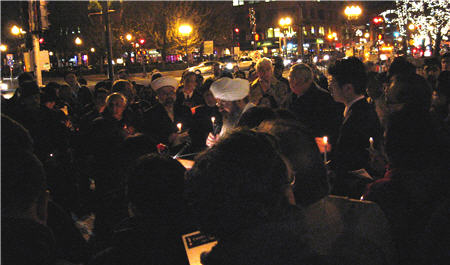 I quickly read a few other messages; they were long and heartfelt.
I quickly read a few other messages; they were long and heartfelt.
The attack upset me deeply. In trying to stay connected and inform my worry, I was surprised by how much the geographical distance actually mattered. The U.S. mainstream media — television, radio, and Internet — were blank. The Web provided pockets of information and corners for emotional togetherness, but searching for them became too much (though I did find a few sites I can turn to in the future).
Sometimes conversation isn’t useful, and images shouldn’t be processed alone. I am grateful to the organizers of tonight’s gathering for bringing people together, and giving us thoughtful people to listen to. I hope the people of Mumbai know just how much their loss of life and security has touched people so far away.
Why Are the (Early) Voting Lines So Long?
November 3, 2008
Why are the early voting lines so long… and why did NPR’s Carrie Kahn just report about them like they’re a big block party? We’re talking three to five hours long, when more than a half hour should be considered undemocratic.
A long voting line is not an act of nature. It is not inevitable. Nor can it be attributed to surprisingly high voter turnout — after the past eight years, there’s no surprise. Besides, election officials should have methods for handling “surprises” within their jurisdictions. Even with early voting.
“This has the potential to disenfranchise a heck of a lot more people than, dare I say it, hacked electronic voting machines,” said Tova Wang, vice president for research at Common Cause, which has been monitoring potential balloting problems ahead of this week’s vote. (LA Times, 11/2/08)
I want to know how and why long voting lines happen. If we don’t ask, and we don’t know, then we can’t press for change. We’re down to the wire now. If it’s true that the presidential race looks different when pollsters ‘narrow the pool of responses from registered voters to likely voters,’ then there should be no block-party reporting where voting isn’t smooth.
Credit Card Isolationism
October 21, 2008
Sometimes it feels that there’s a conspiracy to keep U.S. citizens from leaving the country or even wanting to. In addition to the obvious news media blackout and cultural isolationism (e.g. denying entry visas to world performers), there are passport processing delays, sky-high airfares, a weak dollar, and now… our credit cards don’t even work in Europe.
A year ago in France I had no problem except at train ticket kiosks. But two weeks ago, I was able to use my Citibank Mastercard at only three vendors during a one-week visit. And those had to be convinced to try. I called Citibank and a helpful supervisor explained: Europe now requires all credit cards to have a chip (a gold square embedded in the plastic card) and a pin. These are credit, not debit, cards, and you securely enter the pin at the point of purchase. (The supervisor said she wasn’t informed of this issue until customers started calling in.)
A Boston Globe article and this other good article confirm that I am not alone.
The Citibank supervisor searched her list for a card with a chip and pin that I could get, but found none. According to the Globe article, there won’t be any for a while:
“It would be costly to change all the transaction terminals in the US,” says Don Rhodes, director of risk management policy at the [American Bankers’ Association], “and right now the industry doesn’t seem to feel the level of fraud justifies it.”
Great. To the already compromised reputation of American travelers, we can now add “backwards” and “unable-to-pay”. I wish I could threaten these credit card companies that we travelers might just get used to life without credit cards. But I’d be lying. I want one, and I want it to work everywhere I go.
Addendum 10/22/08: Here’s a more detailed article in the Globe about the debate over the costs and benefits chip-and-pin card deployment. Why can’t the credit card companies offer U.S. consumers chip-and-pin cards with the magnetic strip without immediately updating the U.S. transaction terminals? When in the U.S., the magnetic strip is read, and when in Europe, the chip-and-pin is read. The cynic in me suspects there is no good reason for not doing this, while the idealist in me looks forward to a good explanation, which I will share should I come across it.
Sarah Palin Just Wasted My Time
September 28, 2008
John and I just returned from a month of U.S. travel (travel-logs are forthcoming). Our mutually agreed news blackout was quickly obliterated by Hurricane Ike, and we were then free to marvel at the nomination of 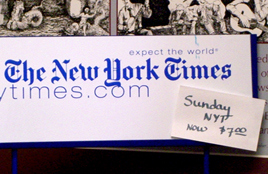 Sarah Palin and the painful circus of financial collapse and executive bailout. Our primary sources were motel CNN, John’s BlackBerry, and the very occasional New York Times. And boy was I hungry after a week in Montana where the only New York Times we could find was in downtown Missoula. The Sunday issue. For seven dollars. On Tuesday.
Sarah Palin and the painful circus of financial collapse and executive bailout. Our primary sources were motel CNN, John’s BlackBerry, and the very occasional New York Times. And boy was I hungry after a week in Montana where the only New York Times we could find was in downtown Missoula. The Sunday issue. For seven dollars. On Tuesday.
We’re home for a few days before heading off again. After weeks of being teased by television, BlackBerry-friendly newspaper sites, and email forwards, I’ve finally caught up on the internet video party. In this realm, it’s no contest between the financial scandals and Sarah Palin. Wall Street execs are smart enough to keep a low profile. So here’s what I’ve watched so far:
- the unsurprisingly “enhh” Saturday Night Live skit
- the surprisingly unimaginative Daily Show coverage
- the jaw-dropping Katie Couric interview
- the friendly-ish Sean Hannity interview (yawn)
- the truly excellent Charlie Gibson interview
At this point, I decided there was no need to watch Palin’s RNC speech, or even voyeuristically dig for videos of the child she’s leading into motherhood and (possible) marriage. The New York Times put it well in a Sept 13 editorial:
If [John McCain] seriously thought this first-term governor — with less than two years in office — was qualified to be president, if necessary, at such a dangerous time, it raises profound questions about his judgment. If the choice was, as we suspect, a tactical move, then it was shockingly irresponsible.
Nearly as shocking is that Palin accepted. Sarah Palin does not know just how much she does not know. That is beyond stupid, it’s dangerous.
I am glad to have had only a couple of days for this bullshit. She’s wasting everyone’s time. Except that of McCain and his staff, who didn’t waste much time vetting her. Seasoned journalism operations and world leaders are having to treat this joker as though she is a real player. I have enjoyed learning about this nutter, but I should have been doing it in furtive scans of People magazine while in the doctor’s office.
However, don’t think for a minute I’ll be missing that VP debate… I’m searching for pubs in Kent with satellite dishes and Tivos as soon as I hit “Publish” on this post.
On Childhood Propensities… and Dreams
August 18, 2008
I spent last weekend in Western Massachusetts, visiting my parents and enjoying a summer performance in the fresh mountain air at Tanglewood.
Freed from the seemingly endless To Do list of my Cambridge life, I embraced one of those projects that nearly always ends up at the bottom of the pile. I descended into my parents’ basement to winnow a few boxes of personal memorabilia. They were mostly grade school and college notebooks, awards certificates, and personal essays assigned by voyeuristic middle school “English” teachers who know they’re panning for gold during a rush.
Even a media girl will tolerate only so many boxes of dormant paper, because someday her parents will make her store them herself. At least computers arrived partway through this lifelong accumulation of paper, creating the illusion that one is a minimalist (and then making it a reality through malfunction or obsolescence). But, with the paper that remains, it’s so hard to know what to keep and what to throw.*
However, there was no question as to the fate of one yellowed 8 1/2″ x 11″ sheet of paper. In 1987, a summer school teacher wrote a brief evaluation of my participation in a class where we made our own magazine:
Rekha was a fast learner in the art of “lay-out” and “paste-up.” She has a good logical mind for organizing material, and likes to add her own creative touch to the format of a magazine. I appreciated the leadership she provided as editor and enjoyed working with her on her own articles.
I was thirteen years old. In the years that followed, I considered careers in interior decorating, environmental law, medicine, architecture, photography, international diplomacy, or something that would fulfill my eighth grade class designation as First to Make a Million. I eventually faced my destiny and went into media… and here I am, 20 years later, laying out digital objects and curating content with logic and creativity. I might have saved myself a lot of searching if I had paid attention to these little indicators. Then again, what I do now didn’t exist back then.
ADDENDUM
[Because I was reminded that truth, edited for narrative flow, will still be treated as truth (see comments).] There’s another story about how my earliest memories include sitting in the back of my parents’ car, listening somewhat involuntarily to NPR. And how, while a teenager, lots of people told me I had a great voice, and that I should be a journalist, and how I agreed but for many years I was too scared to try. But that’s going to have to wait until I find another artifact to peg it on.
————————
*I would be curious as to other people’s criteria for retaining or letting go of personal artifacts over the years.
A Promotion Gone Wildly Random
August 6, 2008
Or not? Is there a connection I should know about between the electronics enthusiasts on Newegg.com and laundry hampers? Are you about to make a joke about geeks who don’t attend to personal cleanliness? Is that fair? Is that’s even what’s going on here, or was there just an overstock on laundry hampers? So many questions.
Microblogging Is Not For Losers
May 1, 2008
When people talk about microblogging they usually mention twitter. That has a distancing effect on me, because I don’t take twitter all that seriously. (Quick explanation: microblogging is blogging, but with more frequent updates of very little text – less than 200 characters.)
So, I hear “microblogging”, and I think, “that thing I can’t relate to.” Or, when I’m feeling darker, I think, “that thing that serves as yet another indicator of the degeneration of our society’s communications and eventually, society itself.” (Kind of like this comment and the one below it on flickr’s Atrocious Apostrophe’s [sic] group.)
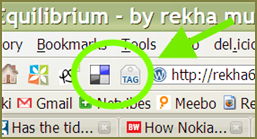 But I can be slow sometimes, it’s true. No, really. Yesterday, while perusing my many RSS feeds, I saw the word “microblogging”, had one of my above thoughts, and then resumed surfing. Saw a link I liked, and clicked the delicious add-on button in my Firefox browser. (Quick explanation: delicious lets you save Web sites and share them with other people who use delicious.)
But I can be slow sometimes, it’s true. No, really. Yesterday, while perusing my many RSS feeds, I saw the word “microblogging”, had one of my above thoughts, and then resumed surfing. Saw a link I liked, and clicked the delicious add-on button in my Firefox browser. (Quick explanation: delicious lets you save Web sites and share them with other people who use delicious.)
And as I began to enter text in the notes field of the “add bookmark” popup, I finally realized:
I’m a microblogger, too.
:-)
**Update: Russell Buckley of MobHappy writes an interesting roundup of the Web 2.0 Expo that I attended last week. He muses on twitter’s version of microblogging, and, incidentally, includes a spot-on critique of conferencing techniques that I, too, find to be not useful at all.
Connecting The Disconnects At Harold & Kumar 2
April 27, 2008
After an intense and fun week at Web 2.0 Expo in San Francisco, I played dumb yesterday. Slept in a meadow at World’s End, and capped off the day with “Harold and Kumar Escape From Guantanamo Bay“.
I LOVED “Harold & Kumar Go To White Castle” – watched it five times. Not only were the jokes hilarious, the entire movie flowed like a well-choreographed dance. Guantanamo Bay was, unsurprisingly for a sequel, lame. The experience revealed two disconnects that I feel like noting.
1) A.O. Scott’s review in the New York Times leaves you wondering if he liked it or not, but clear that he saw something of substance in it. The movie was not good (though not unenjoyable), and it lacked substance. That indicates to me that Mr. Scott hedged, reluctant to dismiss the film outright for fear of being uncool, or perhaps to compensate for his publication’s having neglected the brilliance of White Castle (lackluster “review” — or, rather, plot summary — here). Or both. Disconnect #1.
2) When Neil Patrick Harris first appeared on the screen at the Harvard Square theater, I hooted, confident that I’d trigger a hearty response in the pleasantly energetic audience. But no. Silence. I’ll admit that I first thought this told me something about the uptightness of Harvard students, who appeared to predominate. But then it dawned on me that if my memories of Doogie Howser are hazy, theirs don’t exist. That NPH currently appears in the sitcom, “How I Met Your Mother,” is unremarkable, according to my 17-year-old cousin (and aforementioned silence). Disconnect #2.
So “Harold & Kumar Escape From Guantanamo Bay” has college-age humor, cameos for thirtysomethings, and an ancestral mystique that gets it top-level press. All the right ingredients to get us in the theater door and help the movie do what sequels do best: Make more money without having to make more ideas.
Santa Monica and Los Angeles
March 31, 2008
A few weeks ago I stayed with friends in Santa Monica. I covered a lot of ground in a short period of time.
This travel-log cata-logs the shops, restaurants, parks, and other things I encountered, some of which you might want to encounter too, if you live there or visit.
Murdoch Makes A Difference, One News Article At A Time
March 25, 2008
John read this passage about the Dalai Lama in The Times of London in an article entitled, “Defiant people yearn for the ‘political monk in Gucci shoes'”:
When he won the Nobel Peace Prize in 1989 he described himself as “a simple monk from faraway Tibet”. His existence as a symbol of the struggle for freedom have won him a huge following in the West. But his position is complicated; he has been described as “a very political old monk shuffling around in Gucci shoes”.
John then wrote the following letter to The Times:
Interesting that the journalist does not mention that the person credited with the “monk in Gucci shoes” remark is none other than the proprietor of The Times, Rupert Murdoch. Mr Murdoch is hardly the most objective commentator given his considerable efforts to curry favour with the Chinese leadership while trying to expand his media empire into China.
I feel the journalist is being a little disingenuous with this omission, especially as the quote is used in the title of the piece…
— John Grant, Cambridge, MA
The BBC attributed the quote in question to Mr. Murdoch back in 1999. What’s striking about the Times reporter’s omission is that this remark did not pass quietly into obscurity. It’s still a favorite for watchers of the media mogul and his Buddhist nemesis.
What’s also striking — and amusing — is that both Murdoch and the reporter in his employ attribute the quote to nameless, faceless others (albeit in the way that a child closes her eyes and thinks no one can see her):
Murdoch, 1999: “I have heard cynics who say he’s a very political old monk shuffling around in Gucci shoes.” (I can’t source the original Vanity Fair interview where Murdoch reportedly said this because, as with much of our cultural heritage, it’s buried in some paid archive management service.)
Reporter, 2008: “…he has been described as ‘a very political old monk shuffling around in Gucci shoes'”.
Murdoch is known to strongly influence the coverage of the media properties he owns. But it’s always a little shocking to see that influence in action. Nice catch, John.
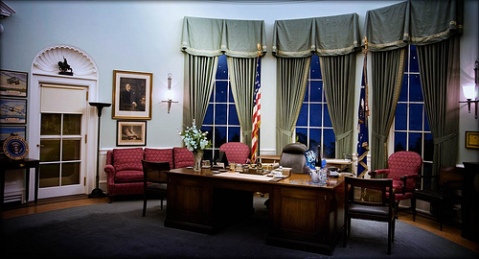
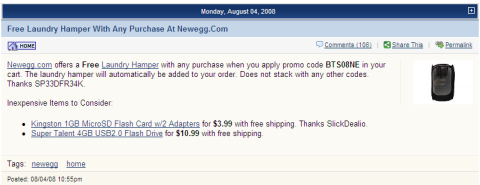
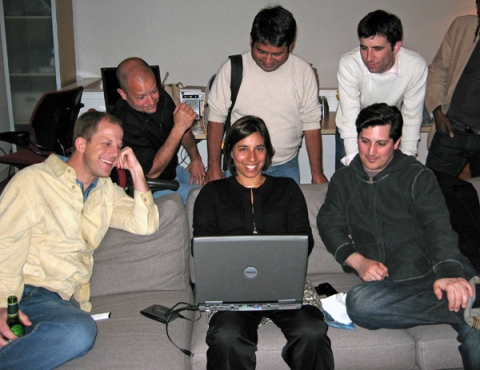



 RSS Feed
RSS Feed